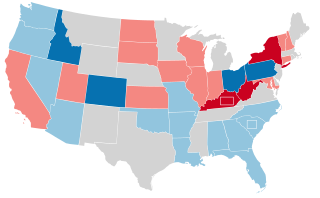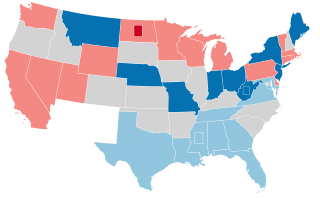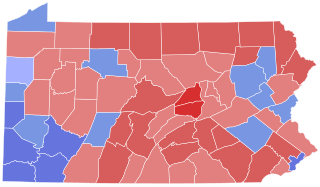
The 1988 United States Senate elections were elections for the United States Senate. Held on November 8, the 33 seats of Class 1 were contested in regular elections. In spite of the Republican victory by George H. W. Bush in the presidential election, the Democrats gained a net of one seat in the Senate. Seven seats changed parties, with four incumbents being defeated. The Democratic majority in the Senate increased by one to 55–to–45.

The 1982 United States Senate elections were held on November 2, 1982. They were elections for the United States Senate following Republican gains in 1980. The 33 Senate seats of Class 1 were up for election in 1982. A total of four seats changed hands between parties, with Democrats winning seats in New Jersey and New Mexico, and Republicans taking seats in Nevada and the seat of the lone independent, Senator Harry Byrd Jr., in Virginia. Democrats made a net gain of one seat bringing them to 46 seats, while Republicans stayed at 54 seats for a majority. However, the Democratic gain in New Jersey replaced a Republican that had been appointed earlier in the year.

The 1980 United States Senate elections were held on November 4, coinciding with Ronald Reagan's victory in the presidential election. The 34 Senate seats of Class 3 were contested in regular elections. Reagan's large margin of victory over incumbent Jimmy Carter gave a huge boost to Republican Senate candidates, allowing them to flip 12 Democratic seats and win control of the chamber for the first time since the end of the 83rd Congress in January 1955.

The 1976 United States Senate elections was an election for the United States Senate. Held on November 2, the 33 seats of Class 1 were contested in regular elections. They coincided with Democrat Jimmy Carter's presidential election and the United States Bicentennial celebration. Although almost half of the seats decided in this election changed parties, Carter's narrow victory did not provide coattails for the Democratic Party. Each party flipped seven Senate seats, although, one of the seats flipped by Democrats was previously held by a Conservative.

The 1964 United States Senate elections were held on November 3. The 33 seats of Class 1 were contested in regular elections. Special elections were also held to fill vacancies. They coincided with the election of President Lyndon B. Johnson by an overwhelming majority, to a full term. His Democratic Party picked up a net two seats from the Republicans. As of 2023, this was the last time either party has had a two-thirds majority in the Senate, which would have hypothetically allowed the Senate Democrats to override a veto, propose constitutional amendments, or convict and expel certain officials without any votes from Senate Republicans. In practice, however, internal divisions effectively prevented the Democrats from doing so. The Senate election cycle coincided with Democratic gains in the House in the same year.

The 1956 United States Senate elections were elections for the United States Senate that coincided with the re-election of President Dwight D. Eisenhower. The 32 seats of Class 3 were contested in regular elections, and three special elections were held to fill vacancies. Although Democrats gained two seats in regular elections, the Republicans gained two seats in special elections, leaving the party balance of the chamber unchanged.

The 1954 United States Senate elections was a midterm election in the first term of Dwight D. Eisenhower's presidency. The 32 Senate seats of Class 2 were contested in regular elections, and six special elections were held to fill vacancies. Eisenhower's Republican party lost a net of two seats to the Democratic opposition. This small change was just enough to give Democrats control of the chamber with the support of an Independent who agreed to caucus with them, he later officially joined the party in April 1955.

The 1946 United States Senate elections were held November 5, 1946, in the middle of Democratic President Harry S. Truman's first term after Roosevelt's passing. The 32 seats of Class 1 were contested in regular elections, and four special elections were held to fill vacancies. The Republicans took control of the Senate by picking up twelve seats, mostly from the Democrats. This was the first time since 1932 that the Republicans had held the Senate, recovering from a low of 16 seats following the 1936 Senate elections.

The 1914 United States Senate elections, with the ratification of the 17th Amendment in 1913, was the first time that all seats up for election were popularly elected instead of chosen by their state legislatures. And thus it became the first time that they were generally scheduled on Election Day to coincide with the U.S. House elections. The 32 seats of Class 3 were contested in regular elections in 1914. Special elections were also held to fill vacancies. These elections occurred in the middle of Democratic President Woodrow Wilson's first term.

Joseph Finch Guffey was an American business executive and Democratic Party politician from Pittsburgh, Pennsylvania. Elected from Pennsylvania to the United States Senate, he served two terms, from 1935 until 1947.

The 1910–11 United States Senate election were held on various dates in various states. As these U.S. Senate elections were prior to the ratification of the Seventeenth Amendment in 1913, senators were primarily chosen by state legislatures. Senators were elected over a wide range of time throughout 1910 and 1911, and a seat may have been filled months late or remained vacant due to legislative deadlock. However, some states had already begun direct elections during this time. Oregon pioneered direct election and experimented with different measures over several years until it succeeded in 1907. Soon after, Nebraska followed suit and laid the foundation for other states to adopt measures reflecting the people's will. By 1912, as many as 29 states elected senators either as nominees of their party's primary or in conjunction with a general election.

The 2008 United States Senate election in West Virginia was held on November 4. Incumbent Senator Jay Rockefeller won re-election to a fifth term in a landslide, defeating Republican Jay Wolfe by a 27-point margin. Despite this overwhelming win, this remains the last time that a Democrat has won West Virginia's Class 2 U.S. Senate seat. In both of the two subsequent elections for the seat, Republicans have swept every single county.

The 1991 United States Senate special election in Pennsylvania was held on November 5, 1991, after incumbent Republican Senator John Heinz died in a plane crash on April 4 of that year. Democrat Harris Wofford was appointed to the seat by Governor Bob Casey, and won the general election over Republican Dick Thornburgh, a former Governor and U.S. Attorney General. Wofford became Pennsylvania's first Democratic Senator since Joseph S. Clark Jr. left office in 1969. Major-party candidates for this election were chosen by party committees, as the vacancy had happened too late for a primary to be held.

The 1980 United States Senate election in Pennsylvania was held on November 4, 1980. Incumbent Republican U.S. Senator Richard Schweiker decided to retire, instead of seeking a third term.

The 1960 United States Senate election in Wyoming was held on November 8, 1960. Incumbent Democratic Senator Joseph C. O'Mahoney was first appointed to the U.S. Senate from Wyoming's Class 1 Senate seat in 1934, and was re-elected in 1934, 1940, and 1946 before losing re-election in 1952. He was then elected to the Class 2 Senate seat in 1954. O'Mahoney, in failing health and increasingly limited in his mobility, declined to run for a fifth non-consecutive term in the Senate. The winner of this election, Keith Thomson, died before assuming his elected office.

The 1962 United States Senate election in Pennsylvania was held on November 6, 1962. Incumbent Democratic U.S. Senator Joseph S. Clark, Jr. successfully sought re-election to another term, defeating Republican nominee James E. Van Zandt.

The 1946 United States Senate election in Pennsylvania was held on November 5, 1946. Incumbent Democratic U.S. Senator Joseph F. Guffey sought re-election to another term, but was defeated by Republican nominee Edward Martin. This was the last time that the Republican candidate won Philadelphia in an election for the Class 1 Senate seat.

The 1934 United States Senate election in Pennsylvania was held on November 6, 1934. Incumbent Republican U.S. Senator David A. Reed sought re-election to another term, but was defeated by Democratic nominee Joseph F. Guffey.

The 1940 United States Senate elections in Arizona took place on November 5, 1940. Incumbent Democratic U.S. Senator Henry F. Ashurst ran for reelection to a sixth term, but was defeated in the Democratic primary to challenger Ernest McFarland.

The 1940 United States Senate election in Delaware took place on November 5, 1940. Incumbent Republican U.S. Senator John G. Townsend Jr. ran for re-election to a third term in office, but was defeated by Democrat James M. Tunnell. This was the only seat that Democratic flipped during this cycle. This was the last time Democrats won Delaware's Class 1 Senate seat until Tom Carper's victory over Senator William Roth in 2000.























